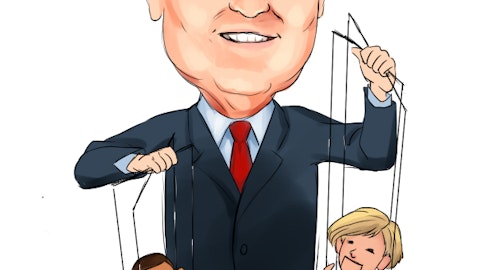Operator: [Operator Instructions]. Your next question comes from Rudy Kessinger with D.A. Davidson.
Rudy Kessinger: Hey, thanks for taking my question. So I just want to understand, I mean, you guys gave that guide halfway through Q1. When exactly in the quarter did these customers start repricing contracts and adding other CDNs and moving share, et cetera? And with these repricings, I guess, you guys just have no control over it whatsoever. And they just asked for repricing, you guys do it within a couple of days. I mean, I just don’t understand how, you know, three months ago, you told us you didn’t have any barge repricing expected. And now, it turns out you did within a six-week time frame.
Ronald Kisling: Yes, I think a couple of things. I think in terms of the dynamics that Todd spoke about, both in terms of the pricing, a lot of that arose really at the end of March and in early April, when we saw, one, the motion of some of our customers, kind of, reversing their trend to consolidating on CDNs, which affected our traffic projections for the year. And then as we engage in some of the rerates that we knew were coming, those negotiations resulted in bigger discounts than we thought that did not come with the typical increase in traffic that we’ve seen historically. And so those were the big drivers. I would say the timeframe really was late March, early April, when we saw these different dynamics. But all affecting some of our largest customers that have an outsized impact on our revenue outlook and growth rate.
Rudy Kessinger: Okay. And so is it larger-than-expected pricing pressure? I guess, it would go against the conventional wisdom when several of the smaller low-cost vendors have exited the space over the last six months. And so just any thoughts on why you had to concede so much on price with less traffic growth than typical, given there’s fewer competitors, fewer low-cost competitors in the space? And then lastly, Ron, just what level of visibility do you have to second-half revenue? Like what percent of that second half — implied second-half revenue guide is actually the minimum commitment?
Todd Nightingale: Yes, I’ll take the first half. I think — look, I think it’s a fair question. We did see — the pricing and traffic projections changed a lot at the end of the quarter and the beginning of this quarter, Q2. But I think it’s — I think, an important piece of it is, look, a small number of accounts where we had — where our projection, our revenue projection has pulled back. And those are large accounts that have very significant swing and they need to be handled and managed and optimized very specifically. It’s why we’re changing our motion there and look I believe we have an opportunity to move back to growth in those accounts. But our projection reflects where we currently are.
Ronald Kisling: I think the only thing I would add on the second part is again a significant portion of our business is utility basis. The largest accounts had their pricing and all these adjustments in traffic still in March and April. And so our outlook reflects those activities that occurred in those largest accounts, and so the variability in the smaller accounts should have less volatility as we move through the year.
Operator: Your next question comes from Jeff Van Rhee with Craig-Hallum.
Unidentified Analyst: Thanks for taking my questions . It’s Daniel on for Jeff. You referenced earlier the volatility with some of the larger customers. Can you just expand on in terms of volatility, the volatility as a term referencing some one-time changes or some quarterly changes, just to this quarter? Just what did you mean in terms of some of the volatility?
Todd Nightingale: Yes, we had a couple of accounts in that very large set that negotiated rerates in the past quarter. Usually, a rerate like that would come up — would come with like a commensurate volume increase. And we tried to model that very carefully. But our projections there was a little bit aggressive, I believe. And we have seen this trend towards — which we saw a strong trend last year for vendor consolidation, as folks with, you know, five or six CDN vendors consolidate all the way down to two or three. We saw a little bit of pulling back there and people adding a vendor here and there. And those two trends caused some volatility which affected our projections.
Unidentified Analyst: And then just a second for me on I believe earlier when you were asked about the assumptions contemplated in the guidance and just with the top 15 customers, what sort of is baked in in terms of the traffic levels? Let me just read you back and see if I got that correct. With the notion that you expected you were modeling in for those traffic levels to stay flat from Q2 into Q3 and Q4, although you actually thought that was conservative, you thought it could actually tick up from Q2. Is that correct? And what would you think would drive those to actually go back up somewhat here in Q3 and Q4?
Todd Nightingale: What we’re modeling all the time is sort of the seasonality of our traffic patterns. But I believe we have an opportunity to increase the revenue and the wallet share at those large accounts by demonstrating superior performance , showing and demonstrating the ROI, using Fastly more clearly, and expanding the product portfolio that those accounts use. And so it’s why I think it was so pertinent for us to really change our engagement model and move very quickly here to react to what we’re seeing in the market, why we are pushing so hard on that right now.
Operator: And ladies and gentlemen, that concludes our question-and-answer session. I will now turn the conference back to Mr. Todd Nightingale for closing remarks.
Todd Nightingale: Thanks so much. I want to thank all our employees, our customers, our partners, and our investors. We remain focused on execution, bringing lasting growth to our business, and delivering real value to all of our shareholders. Thank you so much for your time today.
Operator: Ladies and gentlemen, this concludes today’s call, and we thank you for your participation. You may now disconnect.
Follow Fastly Inc. (NYSE:FSLY)
Follow Fastly Inc. (NYSE:FSLY)
Receive real-time insider trading and news alerts





